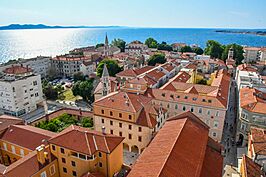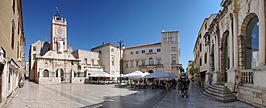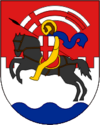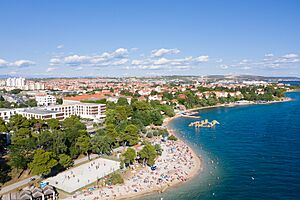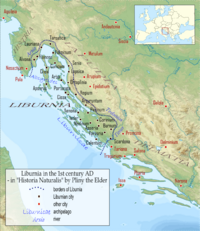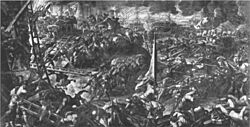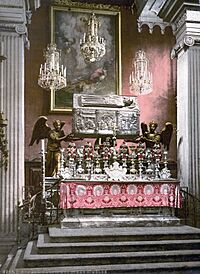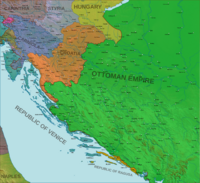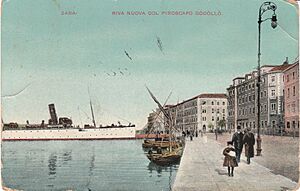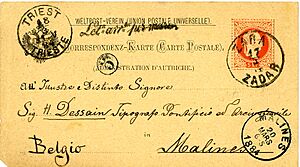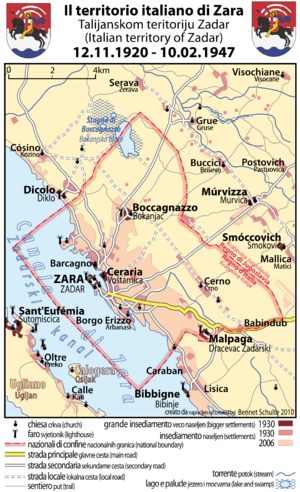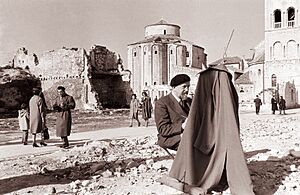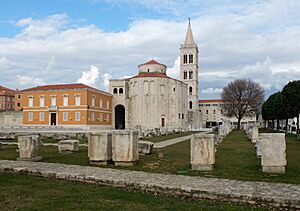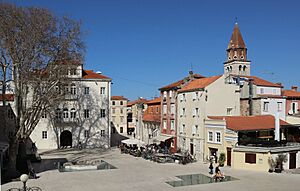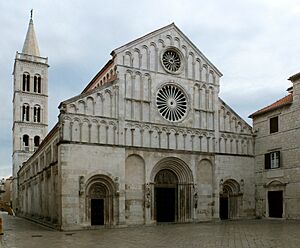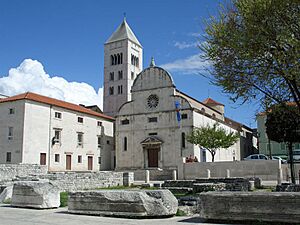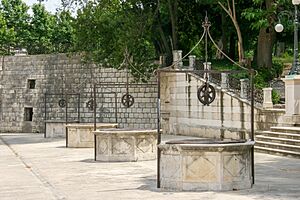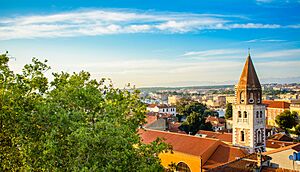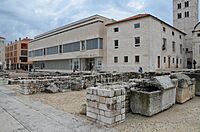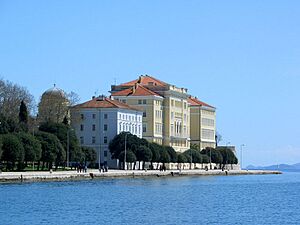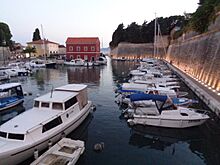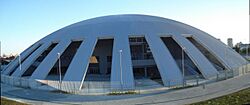Zadar facts for kids
Quick facts for kids
Zadar
Zara
|
|||
|---|---|---|---|
| Grad Zadar City of Zadar La città di Zare |
|||
|
Clockwise from top: Panoramic view from Cathedral Bell Tower, University of Zadar, Monument to the Sun, People's Square, Zadar bridge, Church of St. Donatus and Bishops' palace on the Ancient Roman Forum.
|
|||
|
|||
| Country | Croatia | ||
| County | Zadar County | ||
| Liburni settlement | 9th century BC | ||
| Roman foundation Colonia Iulia Iader |
48 BC | ||
| Area | |||
| • City | 192.4 km2 (74.3 sq mi) | ||
| • Urban | 51.3 km2 (19.8 sq mi) | ||
| • Metro | 194 km2 (75 sq mi) | ||
| Population
(2021)
|
|||
| • City | 70,779 | ||
| • Density | 367.87/km2 (952.79/sq mi) | ||
| • Urban | 67,309 | ||
| • Urban density | 1,312.1/km2 (3,398/sq mi) | ||
| Time zone | UTC+1 (CET) | ||
| • Summer (DST) | UTC+2 (CEST) | ||
| Postal code |
HR-23 000
|
||
| Area code(s) | +385 23 | ||
| Vehicle registration | ZD | ||
| Patron saints | Saint Anastasia Saint Chrysogonus Saint Simeon Saint Zoilus |
||
| UNESCO World Heritage Site | |||
| Official name | Venetian Works of Defence between the 16th and 17th Centuries: Stato da Terra – Western Stato da Mar | ||
| Criteria | Cultural: iii, iv | ||
| Inscription | 2017 (41st Session) | ||
| Area | 378.37 ha | ||
Zadar is a very old city in Croatia. It has been lived in continuously for a long time. Zadar is located on the Adriatic Sea, in the northwest part of the Ravni Kotari region. It is the main city of Zadar County and the northern Dalmatia area.
The city itself covers about 25 square kilometers. In 2011, it had a population of 75,082 people. This makes Zadar the second-largest city in Dalmatia and the fifth-largest city in Croatia.
Today, Zadar is a key place for politics, culture, business, and education in Dalmatia. It is also a major transportation hub. Zadar is a very popular place for tourists in Croatia. The Times newspaper called it the "entertainment center of the Adriatic." The Guardian called it "Croatia's new capital of cool."
In 2017, UNESCO added Zadar's old fortified city to its World Heritage Site list. It is part of the "Venetian Works of Defence between the 16th and 17th centuries."
Contents
What's in a Name? Zadar's History
The name Zadar comes from ancient times, like Iadera or Iader. It probably came from an old word for water. The Liburnians, an ancient people, used this name.
The name of the Liburnian settlement was first written down in a Greek text in 384 BC. It called the people of Zadar Iadasinoi. Later, the city was called Idassa by the Greeks.
During Roman times, the name was often written in Latin as Iader or Iadera. The people were called Iadestines or Iadertines. The accent was on the first part of the name. This influenced how the name was said in the early Middle Ages.
Over time, Jadra became Zadra because of how sounds changed. This led to the Croatian name Zadar.
When the city came under the control of the Republic of Venice in the 15th century, its name became Zara. This name was also used by the Austrian Empire later. From 1920 to 1947, it was part of Italy as Zara. Finally, in 1947, it was officially named Zadar.
Where is Zadar?
Zadar is located across from the islands of Ugljan and Pašman. These islands are part of the Zadar Archipelago. A narrow water channel called the Zadar Strait separates them from the city.
The old part of the city is on a piece of land that used to be separated from the mainland by a deep ditch. This ditch has since been filled in. The harbor, which is to the northeast of the town, is safe and large.
Zadar's Weather
Zadar has a climate that is a mix of humid subtropical and Mediterranean. This means it has mild, wet winters and very warm, humid summers.
- Summer: July and August are the hottest months. The average high temperature is around 29-30°C (84-86°F). Temperatures can often go above 30°C (86°F). The highest temperature ever recorded was 40.0°C (104°F). July is the driest month.
- Winter: January is the coldest month, with an average temperature around 7.7°C (46°F). Temperatures below 0°C (32°F) are rare and don't last long. The lowest temperature ever recorded was -12.0°C (10.4°F). Snow is very rare.
- Rain: October and November are the wettest months. It can rain at any time of the year.
- Sea Temperature: The sea temperature ranges from about 10°C (50°F) in February to 25°C (77°F) in July and August. You can usually swim from May to October.
| Climate data for Zadar (Puntamika Borik) 1971–2000, extremes 1961–2020 | |||||||||||||
|---|---|---|---|---|---|---|---|---|---|---|---|---|---|
| Month | Jan | Feb | Mar | Apr | May | Jun | Jul | Aug | Sep | Oct | Nov | Dec | Year |
| Record high °C (°F) | 17.4 (63.3) |
21.2 (70.2) |
22.5 (72.5) |
26.5 (79.7) |
32.0 (89.6) |
35.3 (95.5) |
36.1 (97.0) |
39.0 (102.2) |
34.1 (93.4) |
27.2 (81.0) |
25.0 (77.0) |
18.7 (65.7) |
39.0 (102.2) |
| Mean daily maximum °C (°F) | 10.8 (51.4) |
11.3 (52.3) |
13.6 (56.5) |
16.6 (61.9) |
21.3 (70.3) |
25.2 (77.4) |
28.2 (82.8) |
28.2 (82.8) |
24.3 (75.7) |
20.0 (68.0) |
15.1 (59.2) |
11.9 (53.4) |
18.9 (66.0) |
| Daily mean °C (°F) | 7.3 (45.1) |
7.5 (45.5) |
9.7 (49.5) |
12.9 (55.2) |
17.5 (63.5) |
21.3 (70.3) |
23.9 (75.0) |
23.7 (74.7) |
19.9 (67.8) |
15.9 (60.6) |
11.4 (52.5) |
8.5 (47.3) |
14.9 (58.8) |
| Mean daily minimum °C (°F) | 4.3 (39.7) |
4.3 (39.7) |
6.3 (43.3) |
9.3 (48.7) |
13.5 (56.3) |
17.0 (62.6) |
19.3 (66.7) |
19.3 (66.7) |
16.0 (60.8) |
12.5 (54.5) |
8.3 (46.9) |
5.5 (41.9) |
11.3 (52.3) |
| Record low °C (°F) | −9.1 (15.6) |
−6.4 (20.5) |
−6.8 (19.8) |
0.5 (32.9) |
3.4 (38.1) |
8.2 (46.8) |
12.7 (54.9) |
11.5 (52.7) |
8.0 (46.4) |
2.3 (36.1) |
−1.8 (28.8) |
−6.5 (20.3) |
−9.1 (15.6) |
| Average precipitation mm (inches) | 72.6 (2.86) |
62.5 (2.46) |
63.5 (2.50) |
70.0 (2.76) |
64.7 (2.55) |
54.4 (2.14) |
30.4 (1.20) |
49.6 (1.95) |
104.0 (4.09) |
106.7 (4.20) |
105.6 (4.16) |
95.2 (3.75) |
879.2 (34.61) |
| Average precipitation days (≥ 0.1 mm) | 10.0 | 8.5 | 8.9 | 10.4 | 9.5 | 8.2 | 5.3 | 5.9 | 8.7 | 9.8 | 11.2 | 10.4 | 106.8 |
| Average snowy days (≥ 1.0 cm) | 0.5 | 0.2 | 0.1 | 0.0 | 0.0 | 0.0 | 0.0 | 0.0 | 0.0 | 0.0 | 0.0 | 0.2 | 1.1 |
| Average relative humidity (%) | 72.4 | 70.0 | 71.2 | 72.7 | 73.8 | 71.2 | 67.2 | 69.3 | 73.4 | 73.8 | 73.5 | 72.8 | 71.8 |
| Mean monthly sunshine hours | 114.7 | 146.9 | 186.0 | 207.0 | 275.9 | 303.0 | 350.3 | 322.4 | 246.0 | 182.9 | 123.0 | 108.5 | 2,566.6 |
| Source: Croatian Meteorological and Hydrological Service | |||||||||||||
Zadar's Long History
- Liburnia (9th century BC – 59 BC)
 Roman Empire (59 BC – 476)
Roman Empire (59 BC – 476) Byzantine Empire (476–800)
Byzantine Empire (476–800) Carolingian Empire (800–812)
Carolingian Empire (800–812) Byzantine Empire (812 – 10th century)
Byzantine Empire (812 – 10th century) Kingdom of Croatia (10th century – 1202)
Kingdom of Croatia (10th century – 1202) Republic of Venice (1202–1358)
Republic of Venice (1202–1358) Kingdom of Croatia (1358–1409)
Kingdom of Croatia (1358–1409) Republic of Venice (1409–1797)
Republic of Venice (1409–1797) Habsburg monarchy (1797–1804)
Habsburg monarchy (1797–1804) Austrian Empire (1804–1805)
Austrian Empire (1804–1805) Napoleonic Italy (1806–1809)
Napoleonic Italy (1806–1809) Illyrian Provinces (1809–1813)
Illyrian Provinces (1809–1813) Austrian Empire late Austria-Hungary (1813–1918)
Austrian Empire late Austria-Hungary (1813–1918) State of Slovenes, Croats and Serbs (1918)
State of Slovenes, Croats and Serbs (1918) Kingdom of Yugoslavia (1918–1920)
Kingdom of Yugoslavia (1918–1920) Kingdom of Italy (1920–1944)
Kingdom of Italy (1920–1944) Yugoslavia (
Yugoslavia ( SR Croatia) (1944–1991)
SR Croatia) (1944–1991) Croatia (1991–present)
Croatia (1991–present)
People have lived in the area of Zadar since ancient times. The first signs of human life are from the Late Stone Age. Many settlements date back to the Neolithic period.
Ancient Times
Before the Illyrians, an ancient Mediterranean people lived here. They mixed with the Indo-Europeans to form the Liburnians. Zadar started as a Liburnian settlement around the 9th century BC. It was built on a small stone island, connected to the mainland. This created a natural harbor.
The Liburnians were known as great sailors and traders. By the 7th century BC, Zadar was an important trading center. They traded with the Phoenicians, Etruscans, and Ancient Greeks. Zadar became a main city for the Liburnians.
In 384 BC, the people of Zadar helped fight against Greek settlers. Later, the Romans began to take over the region. In 59 BC, Zadar became a Roman town called municipium.
During a Roman civil war in 49 BC, Zadar supported Julius Caesar. Because of this, Zadar was given the special title colonia Iulia Iader. Roman settlers, often soldiers, moved there.
Zadar became a rich and important city on the eastern Adriatic coast. It had Roman streets, a forum, baths, and a water system. Christianity also came to Zadar early on. By the end of the 3rd century, Zadar had its own bishop.
Early Middle Ages
| Defensive System of Zadar | |
|---|---|

Landward Gate
|
|
| Location | Zadar County, |
| Type | Cultural |
| Criteria | iii, iv |
| Designated | 2017 (41 Session) |
| Part of | Venetian Works of Defence between 15th and 17th centuries: Stato da Terra – western Stato da Mar |
| Reference no. | 1533 |
| Region | Europe and North America |
After the fall of the Western Roman Empire in 481, Zadar became part of the Ostrogothic kingdom. In the 5th century, many buildings in Zadar were ruined. The city was also hit by an earthquake.
In 553, Zadar became part of the Byzantine Empire. In 568, the Avars attacked Dalmatia. Zadar was the only city that survived these attacks. It became the new capital of Byzantine Dalmatia. The city began to be rebuilt.
In the early 9th century, Zadar was briefly held by the Franks. But it was returned to Byzantium in 812. Zadar's economy focused on the sea, fishing, and trade. It became a very important city. The city's people spoke Dalmatian. But by the end of the 9th century, Croatian became more common.
From the late 9th to mid-10th century, Zadar grew a lot. Trade with the nearby Kingdom of Croatia developed. Croatian settlers started to arrive in Zadar. By the 10th century, Croatians were common in all parts of city life.
High Middle Ages
Zadar's growth in the Middle Ages made it a rival to Venice. Venice wanted to control the Adriatic Sea.
In 998, Zadar asked Venice for help against pirates. Venice used this chance to take control of Dalmatia. Zadar had to pay tribute to Venice.
Zadar wanted to be fully independent. From the 1030s, it was a formal vassal of the Byzantine Empire. In 1069, Zadar joined the Croatian state. Later, in 1105, Zadar accepted the rule of the Croato-Hungarian king.
Venice continued to attack Zadar. The city was invaded several times between 1111 and 1183. Zadar rebelled and asked the Pope and the Croato-Hungarian king for help.
In 1202, Zadar was badly damaged. The Venetian leader, Doge Enrico Dandolo, used crusaders to attack the city. The crusaders needed to pay Venice for ships to Egypt. Since they didn't have enough money, Venice made them attack Zadar. The city was looted and destroyed. The Pope even punished the Venetians and crusaders for attacking a Christian city.
Most people who fled Zadar returned in 1204. They freed the city from the crusaders. But in 1205, Venice took control again. Zadar had very strict conditions for peace.
Zadar's trade suffered under Venice. It had more freedom under the Kingdom of Croatia-Hungary. Several revolts happened. Finally, in 1358, Zadar returned to the crown of King Louis I of Croatia-Hungary. This was part of the Treaty of Zara.
In 1409, Venice bought Zadar and its rights to Dalmatia for a small amount of money. Zadar was sold back to the Venetians.
Most people in Zadar during the Middle Ages were Croatian. Croatian was even used in church services. The time between the 11th and 14th centuries was Zadar's golden age. Many churches, monasteries, and palaces were built. The University of Zadar was founded in 1396 by the Dominican Order. It was the oldest university in what is now Croatia.
From 15th to 18th Centuries
After 1409, Zadar was ruled by Venice. It remained the main administrative city of Dalmatia. During this time, famous artists like Giorgio da Sebenico, Luciano, and Francesco Laurana were born in Zadar.
The 16th and 17th centuries brought attacks from the Ottoman Empire. The Ottomans took over the land part of Zadar. The city itself was always at risk. Because of this, new walls and castles were built. These defenses changed the city's look. Many houses and churches were torn down to make space. After 40 years of building, Zadar became the largest fortified city in Dalmatia.
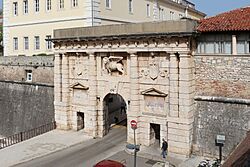
Despite the danger, culture thrived within the city walls. Zadar was influenced by the Renaissance. Many important Italian Renaissance artists and scholars came from Zadar. Croatian writers and poets also became very active.
The population and economy suffered due to the Ottoman threat. Several large outbreaks of bubonic plague also hit the city. After 150 years of danger, Zadar had fewer people and less wealth. Venice sent new settlers. Arbanasi (Catholic Albanian refugees) settled in a new suburb. A new theater, the Teatro Nobile, was built in 1783.
19th and 20th Centuries
In 1797, Zadar became part of the Austrian Empire. It was briefly ruled by Napoleonic Italy and then the French Illyrian Provinces. In 1813, Zadar returned to Austrian control. It remained part of the Austrian monarchy until 1918. Zadar was the capital of the Dalmatia province.
In the 19th century, Zadar began to grow outside its old center. New suburbs were created. The population increased due to economic growth and people moving in. A bridge was built in the city port. Zadar became an "open port." Many print shops, libraries, and theaters opened. Industry also grew.
After 1848, ideas of Italian and Croatian nationalism came to the city. People became divided between Croats and Italians. Official records from the late 19th century show that Italian was the main language spoken by most people in the city. However, in the whole county, Croatians were the majority.
The conflict between Italian and Croatian communities grew. Austria tried to support Croatian culture to reduce Italian influence.
Zadar as Part of Italy (1918–1947)
In 1915, Italy joined World War I. They hoped to gain parts of Dalmatia, including Zadar. After the war, Italian forces took control of Zadar. The Treaty of Rapallo in 1920 officially gave Zadar and some small surrounding areas to Italy.
Zadar became a small Italian province called the province of Zara. In 1921, most people in Zadar were Dalmatian Italians.
World War II and After
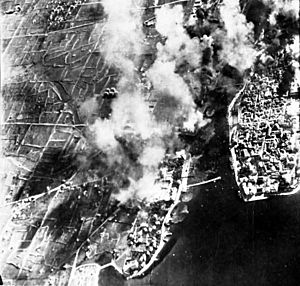
In April 1941, Germany, Italy, and other Axis Powers invaded Yugoslavia. Zadar was a starting point for the invasion. Italy took control of most of Dalmatia. Zadar became the center of a new Italian area.
During World War II, the Allies bombed Zadar heavily from 1943 to 1944. About 80% of the city's buildings were destroyed. Many people died. Zadar is sometimes called the "Dresden of the Adriatic" because of the heavy bombing.
In late 1944, the German army left Zadar. On October 31, 1944, the Partisans took control of the city. Zadar officially became part of Yugoslavia in 1947. After the war, most Dalmatian Italians left Zadar and moved to Italy.
Zadar in Yugoslavia (1947–1991)
After 1947, Zadar was part of Socialist Federal Republic of Yugoslavia and the Socialist Republic of Croatia. The city's population grew slowly at first. The departure of Italians continued.
In the late 1950s and 1960s, Zadar's population grew much faster. This was because people moved from rural areas to cities for jobs. New roads, railways, and an airport helped tourism grow. However, in the late 1980s, Zadar's economy slowed down.
Croatian War of Independence (1991–1995)
In 1990, Serb separatists blocked roads in the Dalmatian Hinterland. This cut off Dalmatia from the rest of Croatia. In March 1991, the Croatian War of Independence began.
The Yugoslav People's Army and other forces occupied parts of Zadar's hinterland. They attacked the city with artillery. Buildings and homes were damaged. UNESCO protected sites were also hit. Land connections with Zagreb were cut off for over a year.
The city was under siege from 1991 until January 1993. Then, Croatian forces took control of Zadar. The bridge connecting Zadar to the rest of Croatia was rebuilt. Attacks on the city continued until the end of the war in 1995. Some areas around Zadar still have land mines.
What to See in Zadar
Zadar's Buildings and History
Zadar's city layout comes from Roman times. During the time of Julius Caesar and Emperor Augustus, the city was fortified. Walls, towers, and gates were built. The city had a forum, a basilica, and a temple. An aqueduct brought water to the town.
In the Middle Ages, Zadar kept its urban look. In the 16th century, Venice built new defensive walls. Many houses and churches were removed to make space for these walls. After 40 years of building, Zadar became a very strong fortified city.
During World War II, many parts of Zadar were destroyed by bombs. But some old buildings still stand.
Here are some important places to see:
- Roman Forum – This is the largest Roman forum on the eastern Adriatic coast. It was built by Emperor Augustus.
- Church of St. Donatus – A large round building from the 9th century. It is a very important example of early Romanesque style.
- St. Anastasia's Cathedral – A beautiful Romanesque church built in the 12th to 13th centuries. It is the largest cathedral in Dalmatia.
- St Chrysogonus's Church – Another impressive Romanesque church.
- St Francis' Church – A Gothic church where the Treaty of Zadar was signed in 1358.
- Five Wells Square – A historic square in the city.
- St Mary's Church – This church has a tall Romanesque bell tower from 1105. It is next to a Benedictine Convent.
- The Land Gate – Designed by the Venetian architect Michele Sanmicheli in 1543.
- The unique sea organ – A modern art installation that plays music using waves.
Zadar's Culture
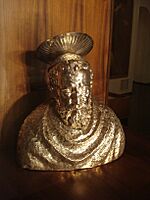
The first university in Zadar was founded in 1396. It was part of a Dominican monastery. It closed in 1807.
Between the 15th and 17th centuries, Zadar was an important Renaissance center. Many architects, sculptors, painters, and scholars came from Zadar. These included Giorgio da Sebenico and Laurana.
Zadar was also a key place for the development of Croatian literature. Many Croatian writers and poets were active here in the 15th and 16th centuries. These included Petar Zoranić, who wrote the first Croatian novel.
Under French rule (1806–1810), the first newspaper in Dalmatia was published in Zadar. It was printed in both Italian and Croatian.
Today, Zadar has many cultural places:
- The Croatian Theatre House
- The National Museum
- The Archaeological Museum (started in 1830)
- The Museum of Ancient Glass
- The University of Zadar (reopened in 2002)
- The Maritime Museum
- Permanent Exhibition of Sacral Art
- Musical Evenings in St. Donatus (a music festival)
Famous People from Zadar
- Pope John IV (died 642), a pope
- Francesco Laurana (c. 1430–1502), a sculptor
- Luka Modrić (born 1985), a famous football player
- Dado Pršo (born 1974), a football player
- Giorgio da Sebenico (c. 1410–1473), a sculptor
- Danijel Subašić (born 1984), a football player
Zadar's Population
| Historical populations of Zadar (municipal) |
||
|---|---|---|
| Year | Pop. | ±% |
| 1880 | 19,778 | — |
| 1890 | 21,933 | +10.9% |
| 1900 | 24,778 | +13.0% |
| 1910 | 27,426 | +10.7% |
| 1921 | 26,241 | −4.3% |
| 1931 | 26,882 | +2.4% |
| 1948 | 23,610 | −12.2% |
| 1953 | 25,465 | +7.9% |
| 1961 | 33,464 | +31.4% |
| 1971 | 50,520 | +51.0% |
| 1981 | 67,154 | +32.9% |
| 1991 | 80,355 | +19.7% |
| 2001 | 72,718 | −9.5% |
| 2011 | 75,062 | +3.2% |
| 2021 | 70,779 | −5.7% |
| Source: Naselja i stanovništvo Republike Hrvatske 1857–2001, DZS, Zagreb, 2005 | ||
Zadar is the fifth largest city in Croatia. It is the second largest in Dalmatia. In 2021, its population was 70,779.
Most of Zadar's citizens are Croats (94.85%). The second largest group are Serbs (1.94%).
| population |
15190
|
16775
|
19778
|
21933
|
24778
|
27426
|
26241
|
26882
|
23610
|
25465
|
33464
|
50520
|
67154
|
80355
|
72718
|
75062
|
70779
|
| 1857 | 1869 | 1880 | 1890 | 1900 | 1910 | 1921 | 1931 | 1948 | 1953 | 1961 | 1971 | 1981 | 1991 | 2001 | 2011 | 2021 |
Zadar's Economy
Zadar's main industries include tourism, transportation, and sea trade. Agriculture, fishing, and fish farming are also important. There are also metal manufacturing, chemical, and banking industries.
Some of the biggest companies in Zadar are:
- Tankerska plovidba (shipping)
- Cromaris (food)
- Bakmaz (retail)
- Sonik (retail)
- Turisthotel (tourism)
- Maraska (food)
- OTP Bank Hrvatska (finance)
The farmland northeast of Zadar, called Ravni Kotari, is known for its marasca cherries. Zadar has been making Maraschino liqueur from these cherries since the 16th century.
Learning in Zadar
Zadar has nine primary schools and 16 secondary schools. This includes six gymnasiums, which are high schools that prepare students for university.
University of Zadar
The University of Zadar was first started by the Dominicans in 1396. It was called Universitas Iadertina and was a school for theology. It was the first higher education institute in Croatia. It closed in 1807.
In 1956, the University of Zagreb reopened it as a part of its Arts campus. In 2003, it became a full, independent university again. Today, the university has 25 departments and over 6,000 students.
Transportation in Zadar
Zadar is an important transportation hub. The main road along the Adriatic coast goes through the city. The Zagreb–Dubrovnik highway is also nearby. Zadar has two exits to this highway.
Buses are the main way to get around Zadar. The city's bus station has inter-city buses that connect Zadar to the rest of Croatia. Local buses also serve Zadar and its suburbs.
Since 2013, passenger trains between Knin and Zadar have been replaced by buses. As of 2020, Zadar no longer has passenger railway connections.
Zadar also has an international ferry line to Ancona, Italy. Ships connect Zadar with its nearby islands from two ferry ports. One is in the city center, and the other is in the south suburb of Gaženica.
Zadar International Airport is about 14 km (9 miles) east of Zadar. It is growing fast, especially with low-cost airlines. These airlines connect Zadar with over 20 cities in Europe from March to October.
Sports in Zadar
Zadar has several sports clubs. The basketball club is KK Zadar. The football (soccer) club is HNK Zadar. The handball club is RK Zadar. The bowling club Kuglački klub Zadar is also very successful.
Many famous Croatian athletes are from Zadar. These include football players Luka Modrić, Dado Pršo, Šime Vrsaljko, and Danijel Subašić. Handball player Ivan Ninčević is also from Zadar.
Zadar's International Connections
Zadar has special relationships with other cities around the world. These are called twin towns or sister cities. They share cultural, economic, and educational ties.
Zadar is twinned with:
- Dundee, Scotland, United Kingdom
- Reggio Emilia, Italy
- Romans-sur-Isère, France
- Fürstenfeldbruck, Germany
- Székesfehérvár, Hungary
- Padua, Italy
- Iquique, Chile
- Banská Bystrica, Slovakia
- Milwaukee, United States
Awards and Honors
Honorary Citizens
These people have been given the title of Honorary Citizen of Zadar:
- 2019: Luka Modrić
- 2021: Tomislav Ivčić
City of Zadar Lifetime Achievement Award
This award recognizes people for their lifelong contributions. Some recipients include:
- 1999: Ivo Petricioli
- 2006: Pavle Dešpalj
- 2020: Janko Bobetko
City of Zadar Award
This award recognizes special achievements. Some recipients include:
- 1996: Igor Kuljerić
- 2005: Šime Fantela, Igor Marenić
- 2011: Ante Gotovina
- 2012: University of Zadar
- 2018: Mihovil Fantela, Šime Fantela, Dominik Livaković, Luka Modrić, Danijel Subašić, Šime Vrsaljko
See also
 In Spanish: Zadar para niños
In Spanish: Zadar para niños


